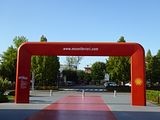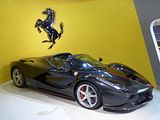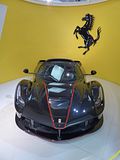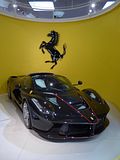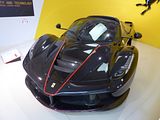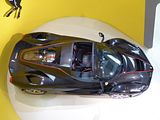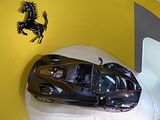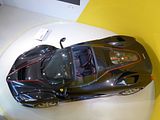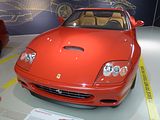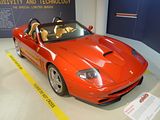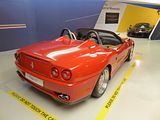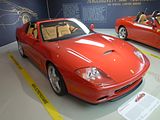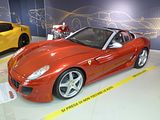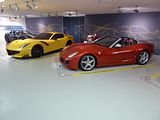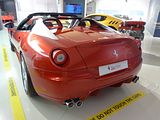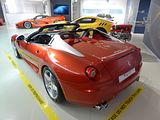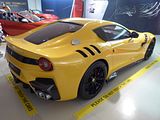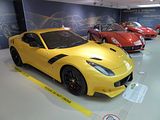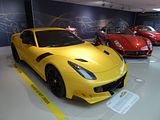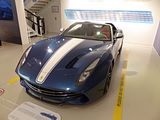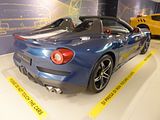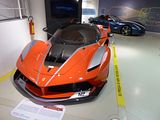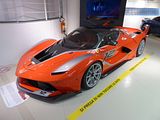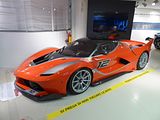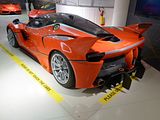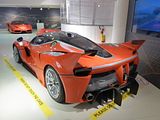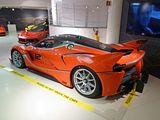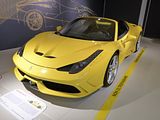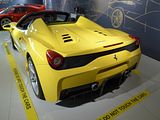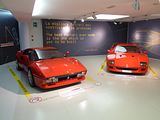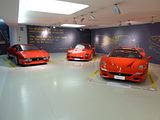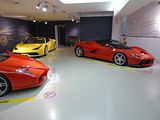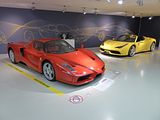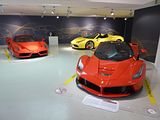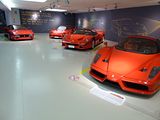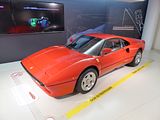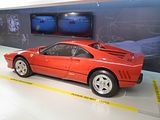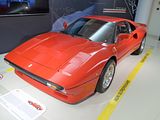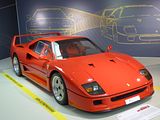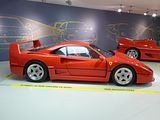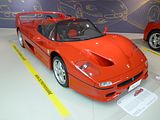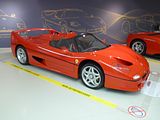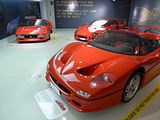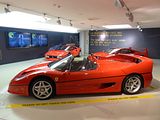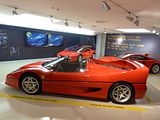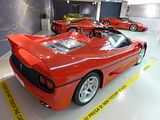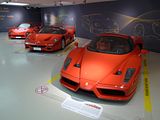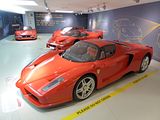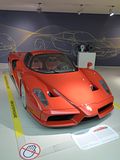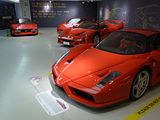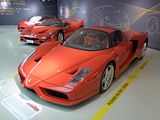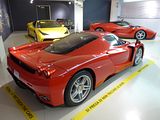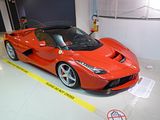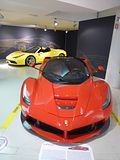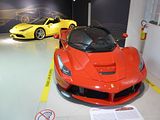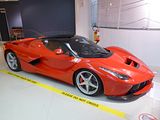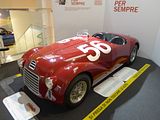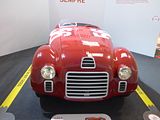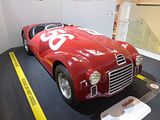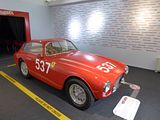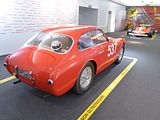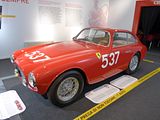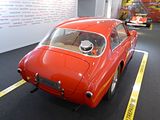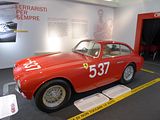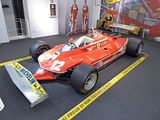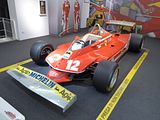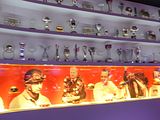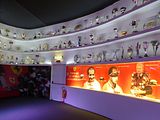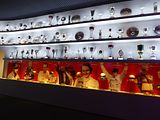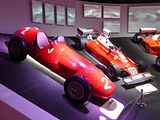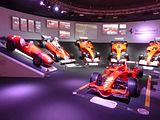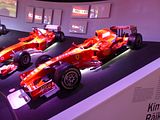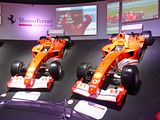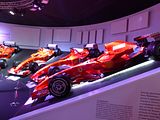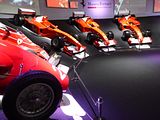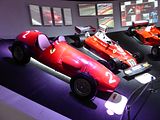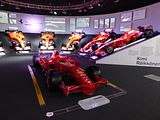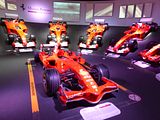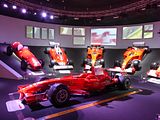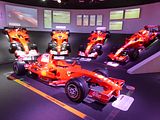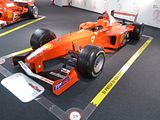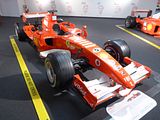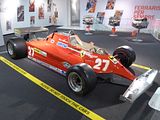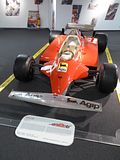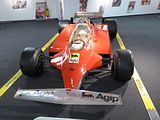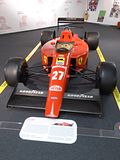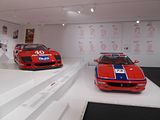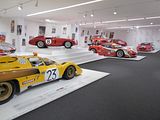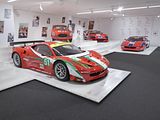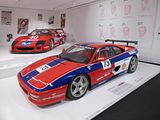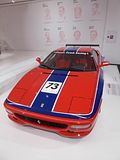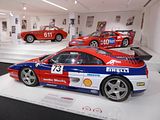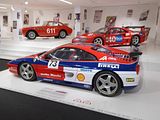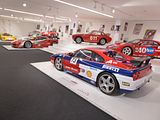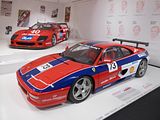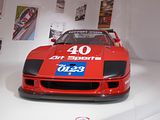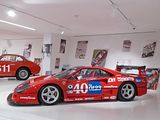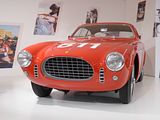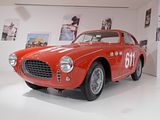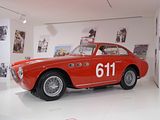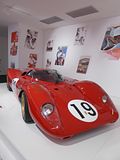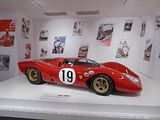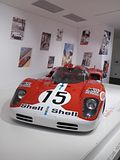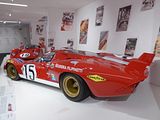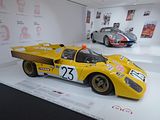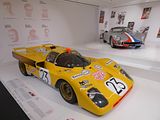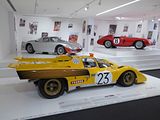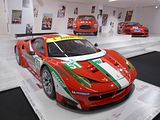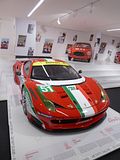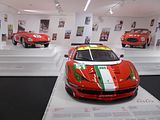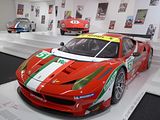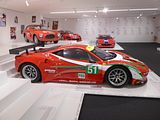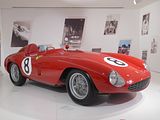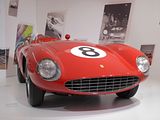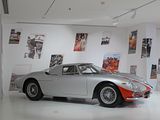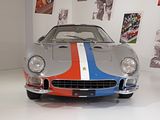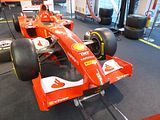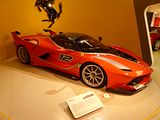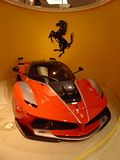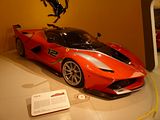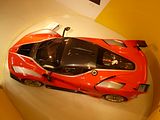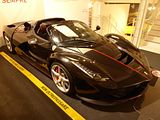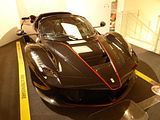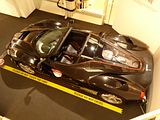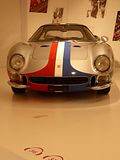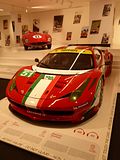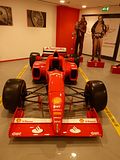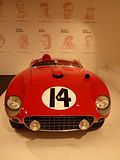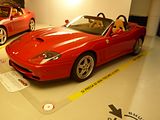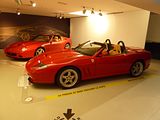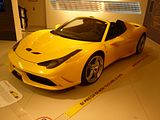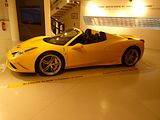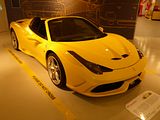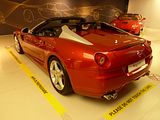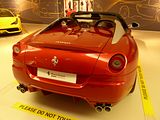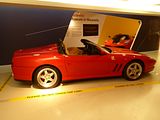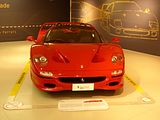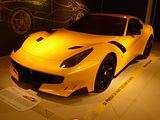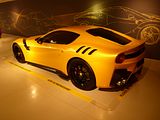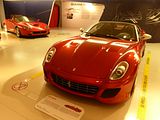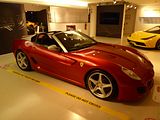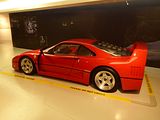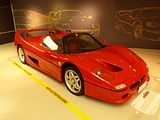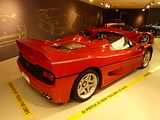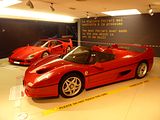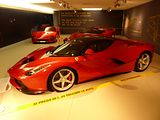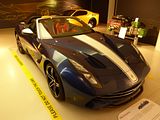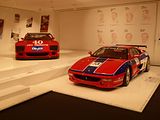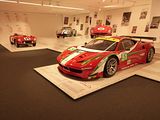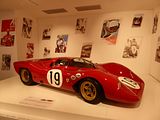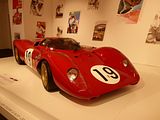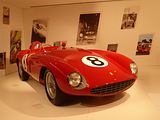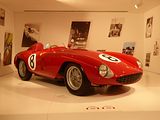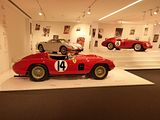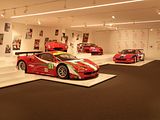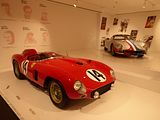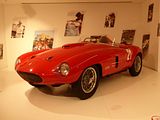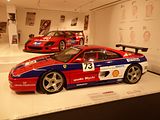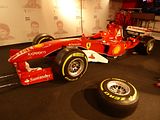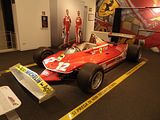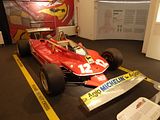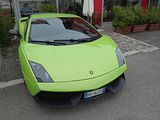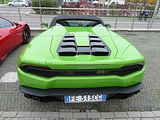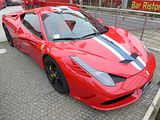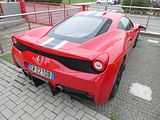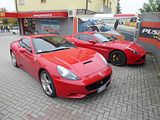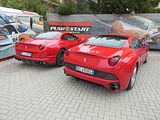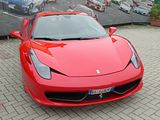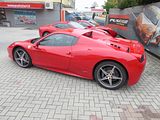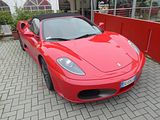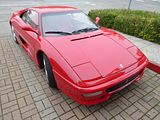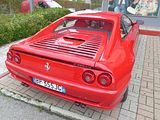A GOOD START
Having bought your entrance ticket – which costs €15.00 per adult, unless you buy a combined ticket for this museum and the Casa Enzo Ferrari which is located in Modena, something I recommend you do, as you can easily fit both locations into one day, then you walk around the corner from the ticket barrier and the first car I came across was this, the brand new LaFerrari Aperta, a model which was first shown only a few weeks earlier at the 2016 Paris Show. The LaFerrari Aperta will be limited to just 210 units. Initially, 200 cars were sold with an additional nine reserved for use during the Ferrari 70th Anniversary celebrations, and then a further model was announced, to be sold by auction. The LaFerrari Aperta comes with a removable carbon-fibre hard top and a removable soft top. Other changes include more efficient powertrain’s control electronics, re-angled radiators to direct air flow out along the underbody rather than over the bonnet, a longer front air dam to help boost downforce, a L-shaped flap on the upper corner of each windscreen pillar to reduce compression on the rear of the cabin in the absence of a roof, different butterfly door angles with different wheel arches and a new carbon fibre insert allowing the doors to rotate. According to Ferrari, all units were already sold to customers via invitation before the public launch.
SPECIAL DISPLAY – LIMITED EDITION CARS
The ground floor contained a display called “Exclusivity and Technology: the Limited Edition Special Series”, which showcased a collection of Ferrari models built in very limited numbers, many of which were also technological milestones. Whilst you do see examples of most of the cars contained in this display at events around the world from time to time, you are hardly ever going to see the ensemble all in one place.
First car that I came to in a hall with some very rare and relatively recent models on show was a 550 Barchetta. This was a fully open-topped version of the regular 550 Maranello and was introduced at the Paris Motor Show in 2000. The 550 Barchetta Pininfarina was a true roadster with no real convertible top provided. The factory did provide a soft top, but it was intended only for temporary use as it was cautioned against using the top above 70 mph (110 km/h), and when you look at what appears to be a rather “Heath Robinson” style piece of canvas anchored over the cabin, you can see why. A total of 448 Barchettas were produced, four more than initially planned due to concerns of superstition in the Japanese market.
There was a second open-topped version of the 550 family of cars. This was the 575M SuperAmerica which was introduced in 2005, as a convertible version of the 575M Maranello, Unlike the open topped version of the earlier 550 Maranello, the 550 Barchetta, which featured an incredibly primitive sort of roof covering, this one featured an electrochromic glass panel roof which rotated 180° (both are production car firsts) at the rear to lie flat over the boot. Patented Revocromico roof incorporates carbon fibre structure that is hinged on the single axis with a luggage compartment lid, allowing the access to the latter even with an open roof. With the roof open the rear window, apart for holding the third brake light, also acts as a wind deflector. This roof design was previously used on 2001-designed Vola by Leonardo Fioravanti. The Superamerica used the higher-output tune of the V-12 engine, F133 G, rated at 533 hp and Ferrari marketed it as the world’s fastest convertible, with a top speed of 199 mph (320 km/h). The GTC handling package was optional. A total of 559 Superamericas were built; this number followed Enzo Ferrari’s philosophy that there should always be one fewer car available than what the market demanded.
The 550/575 cars were replaced by the 599GTB Fiorano in 2006 and in the fullness of time, an open-topped version of this car appeared. Called the SA Aperta it was introduced at the 2010 Paris Motor Show as a unique limited edition in honour of designers Sergio Pininfarina and Andrea Pininfarina. Only 80 examples were released. The SA Aperta used the higher performance engine from the 599 GTO.
Ferrari unveiled the F12 TdF in October 2015, as a faster, lighter and more powerful special edition of the regular car. The accompanying press releases informed us that the the car was created in homage to the legendary Tour de France road races, which it dominated in the 1950s and 1960s with the likes of the 1956 250 GT Berlinetta. However, the full Tour de France name cannot be used, as this is registered to the famous annual cycle race held in France, and even the might of Ferrari’s often belligerent and bullying legal department clearly had not managed to get past that obstacle. The F12 TdF, described by its maker as “the ultimate expression of the concept of an extreme road car that is equally at home on the track”, keeps the same 6.3-litre naturally aspirated V12 engine as the regular F12 Berlinetta, but power has been boosted from 730bhp to 770bhp at 8500rpm, while torque has increased from 509lb ft to 520lb ft at 6750rpm. Ferrari says 80% of the car’s torque is available from 2500rpm. By comparison, McLaren’s 675LT features a 3.8-litre twin-turbocharged V8 engine and produces 660bhp and 516lb ft – enough to give it a 0-62mph sprint time of 2.9 seconds. The older Ferrari 458 Speciale, meanwhile, made 597bhp from its 4.5-litre naturally aspirated V8. The car is capable of reaching 62mph in 2.9sec and has a top speed of more than 211mph. Official fuel consumption is rated at 18.3mpg, with CO2 emissions of 360g/km. Ferrari says it has has used various modifications derived from its F1 cars to boost the engine’s efficiency. The F12 TdF uses a new version of the firm’s dual-clutch automatic transmission, which features shorter gear ratios. New one-piece brake calipers – the same as those used on the LaFerrari supercar – are said to provide “outstanding” stopping distances, allowing the F12 TdF to brake from 62-0mph in 30.5 metres. Ferrari says the car’s performance is “second to none”, but that it has also been conceived to be “an extremely agile and powerful car which could also be driven by less expert drivers”. The F12 TdF has lapped Ferrari’s Fiorano test track in 1min 21sec. The regular F12 Berlinetta completed the lap in 1min 23sec – the same as the new 488. The LaFerrari currently holds the fastest time on the course, with a time of 1min 19.70sec. Among the other changes made to the F12 TdF are larger front tyres, allowing greater lateral acceleration through corners. Ferrari says the car’s “natural tendency” to oversteer has been compensated for by the use of a new rear-wheel steering system. Dubbed Virtual Short Wheelbase, the system – which automatically adjusts the rear wheels for the optimum steering angle – is said to increase stability at high speeds while guaranteeing “the steering wheel response times and turn-in of a competition car”. The F12 TdF’s aggressive bodywork includes a longer and higher rear spoiler, larger air vents to channel air flow along the sides of the car, a redesigned rear diffuser and new wheel arch louvres. It sits on 20in alloy wheels. Overall, the changes combine to give the F12 TdF 30% more downforce compared to the F12. Ferrari says the redesigned bodywork has almost doubled the aerodynamic efficiency of the car compared to the standard F12, while the use of lightweight carbonfibre inside and out has reduced the F12 TdFf’s kerb weight by 110kg over the standard car, which weighs 1630kg. The cabin is deliberately stripped out. The door panels feature carbonfibre trim, while knee padding replaces the traditional glovebox. The majority of the cabin is trimmed with Alcantara instead of real leather. Aluminium plates feature on the floor instead of mats, again hinting at the car’s track-focused nature. Just 799 examples will be built, around 20 of which are ear-marked for the UK, where the asking price is £339,000, which is around £100,000 more than the regular F12 Berlinetta. A prospective owner is likely to have several other Ferrari models.
Also based on the F12 models was the F60 America, a very limited production roadster derivative of the F12, built to celebrate 60 years of Ferrari in North America. Just ten were constructed, and all were already spoken for at the time of the car’s public introduction in October 2014. The open-top configuration pays homage to US-only limited production convertible Ferraris of the past, such as the 275 GTS/4 NART Spider. Compared to the F12, the F60 has all-new bodywork; it uses a light removable soft top instead of a conventional convertible top. Each of the ten examples built features an asymmetrical cabin design with red trim for the driver’s area and black for the passenger, American flag detailing in the centre of the backrests of both seats, and classic blue and white North American Racing Team livery.
These were all road cars. Ferrari has also, in recent times, produced some very limited numbers of cars that were purpose-designed for the track. Indeed, these have not been road-legal, and those lucky enough to afford them have found that Ferrari keeps custody of “their” car, making it available at the track of choice when required. The latest of these is the FXX K, of which just 40 units were made. The FXX K is based on the street-legal LaFerrari. It is a successor to the FXX and the 599XX. The “FXX K” is Ferrari’s research and development vehicle based on Maranello’s first hybrid, the LaFerrari, with the K in the car’s name is referring to the kinetic energy recovery system (KERS) which is used to maximize performance. The FXX-K will not be used in competition and was developed to be uncompromising. The FXX K produces a total power of 1,050 PS (1,036 hp) and over 900 Nm (664 lb/ft), of which 860 PS (848 hp) are delivered by the V12 ICE and 190 PS (187 hp) by the electric motor. The V12 engine has been tuned for track use as well as the HY-KERS system. The FXX-K has extremely effective downforce generation and the result is a downforces of 540 kg (1,190 lb) at 200 km/h (124 mph).[2]. The car has a dry weight of 1,165 kg (2,568 lb).[3] It includes four driving modes: Qualify (maximum performance on short distance), Long Run (for long distance driving), Fast Charge (for faster recharging of the battery) and Manual Boost, that uses all the power of the engine and batteries for maximum torque, cornering and speed. It has F1-based technology, including the E-Diff electronic differential, F1-Trac traction control and racing ABS brakes, all controlled from the centre console (Manettino). Like the preceding FXX and 599XX, the FXX K is a part of Ferrari’s Client Test Driver program, that allows owners of XX cars to drive in special tracks, collecting data for use in future Ferrari road and race cars. The front of the car has a large splitter and twin-profile spoiler, the headlights are very small for improving aerodynamics. In the rear, the tail is higher and includes a mobile spoiler with a tailfin and a small wing in the end of each fin to maximise the downforce. The car was launched at the Yas Marina circuit and “production” began in 2015.
Just 458 of the open topped version, the 458 Speciale A (for Aperta), launched at the 2014 Paris Show, were built,, and they seem to be far rarer than the closed 458 Speciale on which they were based. The mechanical changes to this car are the same as with the Coupe model, and that goes for the styling alterations as well, with the major difference being that, as this is an open car, with a removable roof, you no longer get the glass engine cover. Weighing 50 kg more than the closed car, the quoted performance figures for the two models were the same. Inside. the Speciale A gets blue carbonfibre – exclusive to this model – on the dash, moulded door panels and central tunnel, as well as the newly designed seats in Alcantara with contrasting stitching and 3D technical fabric. A special plaque in the cockpit commemorates the three international ‘best performance engine’ awards the V8 has won. The closed 458 Speciale had followed a long line of specially engineered cars added to complement the “regular” V8 models that started with the 100 units of the 348 Speciale produced in 1992, and followed up by the 360 Challenge Stradale, the 430 Scuderia and the 16M. In essence they are all about adding power and shedding weight. In simplistic terms, the road to the Speciale can be summed up in four words: more power, less weight. There are other, more detailed changes, too, obviously, but those are the cornerstones around which everything else is shaped. The normally aspirated, flat-plane crank V8 retains its 4497cc swept capacity but receives new cam geometry with higher valve lift, shorter inlet manifolds and different pistons providing a higher compression ratio. Internal friction is reduced, through the use of uprated materials and the upshot is 597bhp (up from 562bhp) generated at the engine’s 9000rpm limit. Torque is the same, at 398lb ft, still delivered at 6000rpm. The engine is mated to a seven-speed, dual-clutch gearbox whose upshifts, we were told at the launch of such gearboxes, are all but instant. That’s still true, but Ferrari has improved the response time to a pull on the lever and made the engine rev-match more quickly on downshifts to reduce the time that those take. The engine’s changes shave 8kg from the car’s overall weight – the exhaust is all aluminium and the intake is carbonfibre. Those 8kg form part of a claimed 90kg total saving at 1395kg now, versus 1485kg for a 458 Italia. Of this 90kg, 12kg is contributed by lighter, forged wheels, 13kg comes from bodywork and window changes (lighter glass all round and Lexan for the engine cover), and 20kg comes from the cabin. There are two flaps on the Speciale’s front valance, one either side of the prancing horse badge in its centre. Below 106mph these flaps remain closed, which diverts air towards the radiators. Above that speed, the radiators get quite enough cool air, thanks very much, so the flaps open, which reduces drag. Then, above 137mph, they move again, lowering to shift downforce to the rear of the car, in turn adjusting the balance 20 per cent rearward in order to promote high-speed cornering stability. At the rear, meanwhile, there is a new diffuser (the exhausts have been rerouted to make the most of its central section). Movable flaps in the diffuser adjust, but this time they are dependent not only on speed but also on steering angle and throttle or brake position. When lowered, the flaps stall the path of air into the diffuser and improve the Cd by 0.03. When raised, the diffuser adds downforce as it should. Bodywork changes, though, also bring some aerodynamic improvements, you’ll not be surprised to hear, with lessons applied from the LaFerrari and FXX programmes. In the front valance and under the rear diffuser, there are flaps that open at speed to reduce drag and improve downforce. Finally, there are new Michelin Pilot Sport Cup 2 tyres in a unique compound – rather a sticky one, we suspect – plus new calibration for the adaptive dampers. The carbon-ceramic brake discs also use a new compound. 499 of them were built and they sold out very quickly.
The final series of cars in here were one each of the last 5 special models which we tend now to think of as Hypercars. It is not often you get to see all 5 in one place and certainly not displayed as brilliantly as this. It would be a hard man who said that the entry fee was not worth it just to see these 5 cars alone!
First of these, and still my personal favourite, was the 1984 288 GTO. The GTO was built to compete in the new Group B Race series and a minimum of 200 cars were required for homologation. However, after the death of Henri Toivonen and his co-driver Sergio Cresto in the 1986 Tour de Corse, the FIA disestablished the class, leaving just the Group A Rally championship. As a result, the GTO never raced and all 272 cars built remained purely road cars. Some of the GTO’s styling features were first displayed on a 308 GTB design exercise by Pininfarina shown at the 1977 Geneva Salon. The 288 GTO started out as a modified version of the 308/328 to hold down costs and to build the car quickly, but little of the 308/328 was left when the 288 GTO was finished. Easily noticeable differences were the GTOs bulging wing flares, larger front/rear spoilers, large “flag-style” outside mirrors and four driving lights at the far sides of the grille. Retained from the original 250 GTO were slanted air vents, put in the GTO’s rear wings to cool the brakes. The GTO also had wider body panels than the 308’s because they had to cover much larger Goodyear tyres mounted on racing wheels. The suspension’s height could be set higher for road use and lower for racing on tracks. Bodywork material was new and lighter for better acceleration and handing. The GTO’s weight was only 2,555 pounds, compared to 3,085-3,350 for the 308/328. Steel was used just for the doors because major body panels were made from moulded fibreglass. Kevlar was used for the engine cover, and the roof was made from Kevlar and carbon fibre. The “288” refers to the GTO’s 2.8 litre V8 engine as it used a de-bored (by 1 mm) V8 with twin IHI turbochargers, intercoolers, and Weber-Marelli fuel injection. The 2855 cc engine capacity was dictated by the FIA’s requirement for a Turbocharged engine’s capacity to be multiplied by 1.4. This gave the GTO a theoretical engine capacity of 3997 cc, just under the Group B limit of 4.0 litres. Unlike the 308’s 2926 cc engine, the GTO’s 2855 cc engine was mounted longitudinally, using the 308’s rear boot space. This was necessary to make room for the twin turbochargers and intercoolers. The racing transmission was mounted to the rear of the longitudinal engine, moving the rear differential and wheels aft. The arrangement also let the GTO use a more conventional race-car engine/transmission layout for such things as quick gear ratio changes for various tracks. As a result, the wheelbase was 110 mm (4.3 in) longer at 2,450 mm (96 in). The track was also widened to accommodate wider wheels and tyres to provide increased cornering and braking performance and the ability to apply 400 hp and 366 lb·ft of torque to the ground. The GTO was an impressive performer, with 0-60 mph times around 5 seconds. Ferrari claimed 0-125 mph (201 km/h) in 15 seconds flat and a top speed of 189 mph (304 km/h), making it the first street-legal production car to reach 300 km/h.
The F40 of 1987 was the successor to the 288 GTO. It was designed to celebrate Ferrari’s 40th anniversary and was the last Ferrari automobile personally approved by Enzo Ferrari. At the time it was Ferrari’s fastest, most powerful, and most expensive car for sale. As soon as the 288 GTO was launched, Ferrari started the development of an evolution model, intended to compete against the Porsche 959 in FIA Group B. However, when the FIA brought an end to the Group B category for the 1986 season, Enzo Ferrari was left with five 288 GTO Evoluzione development cars, and no series in which to campaign them. Enzo’s desire to leave a legacy in his final supercar allowed the Evoluzione program to be further developed to produce a car exclusively for road use. In response to the quite simple, but very expensive car with relatively little out of the ordinary being called a “cynical money-making exercise” aimed at speculators, a figure from the Ferrari marketing department was quoted as saying “We wanted it to be very fast, sporting in the extreme and Spartan,” “Customers had been saying our cars were becoming too plush and comfortable.” “The F40 is for the most enthusiastic of our owners who want nothing but sheer performance. It isn’t a laboratory for the future, as the 959 is. It is not Star Wars. And it wasn’t created because Porsche built the 959. It would have happened anyway.” Power came from an enlarged, 2936 cc version of the GTO’s twin IHI turbocharged V8 developing 478 bhp. The F40 did without a catalytic converter until 1990 when US regulations made them a requirement for emissions control reasons. The flanking exhaust pipes guide exhaust gases from each bank of cylinders while the central pipe guides gases released from the wastegate of the turbochargers. Engines with catalytic converters bear F120D code. The suspension was similar to the GTO’s double wishbone setup, though many parts were upgraded and settings were changed; the unusually low ground clearance prompted Ferrari to include the ability to raise the vehicle’s ground clearance when necessary. The body was an entirely new design by Pininfarina featuring panels made of Kevlar, carbon fibre, and aluminium for strength and low weight, and intense aerodynamic testing was employed. Weight was further minimised through the use of a plastic windscreen and windows. The cars did have air conditioning, but had no sound system, door handles, glove box, leather trim, carpets, or door panels. The first 50 cars produced had sliding Lexan windows, while later cars were fitted with wind down windows. The F40 was designed with aerodynamics in mind. For speed the car relied more on its shape than its power. Frontal area was reduced, and airflow greatly smoothed, but stability rather than terminal velocity was a primary concern. So too was cooling as the forced induction engine generated a great deal of heat. In consequence, the car was somewhat like an open-wheel racing car with a body. It had a partial undertray to smooth airflow beneath the radiator, front section, and the cabin, and a second one with diffusers behind the motor, but the engine bay was not sealed. Nonetheless, the F40 had an impressively low Cd of 0.34 with lift controlled by its spoilers and wing. The factory never intended to race the F40, but the car saw competition as early as 1989 when it debuted in the Laguna Seca Raceway round of the IMSA, appearing in the GTO category, with a LM evolution model driven by Jean Alesi, finishing third to the two faster space-framed four wheel drive Audi 90 and beating a host of other factory backed spaceframe specials that dominated the races. Despite lack of factory backing, the car would soon have another successful season there under a host of guest drivers such as Jean-Pierre Jabouille, Jacques Laffite and Hurley Haywood taking a total of three second places and one third. It would later be a popular choice by privateers to compete in numerous domestic GT series. Although the original plan was to build jyst 400 cars, such was the demand that in the end, 1311 were built over a 4 year period.
Fans who wanted to see what Ferrari would do next did not have too long to wait, as the next hypercar, the F50 appeared 4 years later, in 1995. This could almost be seen as a Formula 1 car for the road, as this mid-engined two seat roadster with a removable hardtop had a 4.7 litre naturally aspirated 60-valve V12 engine that was developed from the 3.5 litre V12 used in the 1990 Ferrari 641 Formula One car. Only 349 cars were made, of which 301 were red. Just 4 of them were black, making it, along with silver the least produced colour of the limited palate offered. The last F50 was produced in July 1997. These days this is the rarest of the quintet.
There was a bigger gap before the next car came along. Widely rumoured to be called the F60, Ferrari surprised everyone at its 2002 unveiling by giving it the name Enzo. This car was built using even more Formula One technology, such as a carbon-fibre body, F1-style electrohydraulic shift transmission, and carbon fibre-reinforced silicon carbide (C/SiC) ceramic composite disc brakes. Also used were technologies not allowed in F1 such as active aerodynamics and traction control. After a downforce of 7600 N (1700 lbf) is reached at 300 km/h (186 mph) the rear wing is actuated by computer to maintain that downforce. The Enzo’s F140 B V12 engine was the first of a new generation for Ferrari. It was based on the design of the V8 found in Maserati’s Quattroporte, using the same basic design and 104 mm (4.1 in) bore spacing. The Enzo formed the basis for a whole array of other very special cars, including the FXX and FXX Evoluzione cars and the Maserati MC12 and MC12 Evoluzione as well as the Ferrari P4/5 and the Millechilli. Originally, 349 of these were going to be produced, but Ferrari decided to add another 50 to the total, meaning 400 in total were produced up until 2004.
If you wanted the next in the series, the 2013 LaFerrari, it was almost a pre-requisite that you had bought one of all the others, and probably a few other Ferraris as well. Launched at the 2013 Geneva Show, along with the Porsche 918 Spyder and McLaren P1, the LaFerrari has the distinction of being the first mild hybrid from Ferrari, which ensures that as well as providing the highest power output of any Ferrari, fuel consumption can be decreased by up to 40 percent. Owners may not care, but regulators certainly do! LaFerrari’s internal combustion engine is a mid-rear mounted Ferrari F140 65° V12 with a 6262 cc capacity producing 800 PS (789 bhp) @ 9000 rpm and 700 N·m (520 lbf·ft) of torque @ 6,750 rpm, supplemented by a 163 PS (161 bhp) KERS unit (called HY-KERS), which will provide short bursts of extra power. The KERS system adds extra power to the combustion engine’s output level for a total of 963 PS (950 bhp) and a combined torque of 900 N·m (664 lb·ft). Ferrari claims CO2 emissions of 330 g/km. It is connected to a 7-speed dual-clutch transmission and the car is rear-wheel drive. 499 units were built, each costing over $1million.
ANTE ROOM
Heading upstairs, and the next car I came across was this, the 125S, the very first model to bear the Ferrari badging. Although preceded by Enzo Ferrari’s Auto Avio Costruzioni 815 of 1940, the 125 S was the first vehicle to bear the Ferrari name when it debuted on May 11, 1947 at the Piacenza racing circuit. Like the 815, it was a racing sports car, but unlike its Fiat-powered 8-cylinder predecessor, the 125 S featured a V12 engine (the “125”), a trait it shared with most Ferrari cars of the following decades. Only 2 were built before the 125 S would be replaced by the 159 S later in the year. The 125 S used a steel tube-frame chassis and had a double wishbone suspension with transverse leaf springs in front with a live axle in the rear. Hydraulic power drum brakes were specified front and rear. It was powered by Gioacchino Colombo’s 1497 cc 60° V12, which produced 118 bhp at 6,800 rpm . This was a single overhead camshaft design with 2 valves per cylinder and three double-choke Weber 30DCF carburettors. Enzo Ferrari wanted the 125 S to use a five-speed gearbox as it matched the high revving V12 better than that of a traditional four-speed gearbox. The 125 S debuted at the Circuito di Piacenza, driven by Franco Cortese, but was unable to finish the race, despite a favourable showing against the strong Maserati 6CS 1500s. Two weeks later, the 125 S claimed Ferrari’s first victory at the Grand Prix of Rome on the Terme di Caracalla Circuit, where it was also driven by Cortese. The car had spun a bearing in practice, and was repaired in the workshop of Tino Martinoli, who later came to America with the Ferrari Indy car team. The 125 S won six of its fourteen races in 1947, though drivers Clemente Biondetti and Giuseppe Navone were unable to win the 1947 Mille Miglia in it. Both of the two 125 S cars built in 1947 were dismantled, and their parts are thought to have been re-used in production of the 159 or 166 models. Recently, the chassis with serial number 010I was used in the restoration of a 125 S. It is rumoured that 010I is actually s/n 01C. The story goes that 01C was re-stamped as 010I, and sold to a customer as a new car. Upon taking receipt of the car, the new owner immediately exclaimed, muletto!, which means “Test mule” in Italian, as he could clearly see that his supposedly new car was in fact a used, well-raced car. Ferrari made a new invoice for the car, including a considerable rebate given the car’s second-hand nature. Still in 166 Spyder Corsa configuration, the car was sold to Symbolic Motors. Close inspection of the chassis and its serial number led to the discovery of an old stamping that could possibly read 01C. It had been covered by an aluminium plate which bore the serial number 010I. Subsequently, the car was sold to its current owner, who refitted the chassis with a body similar to the factory’s 125 S replica, which was built by Michelotto in 1987. The alleged 01C made its public debut at the Pebble Beach Concours d’Elegance, and was entered as a “Ferrari 125 S”. The car continues to be the subject of much debate among Ferrari historians and enthusiasts; recent developments indicate that the restamped serial number was in fact a correction and not an alteration.
Making your way through the building you get to a long thin room, which features a couple of cars in the centre of the floor and to one side a reconstruction of Il Commendatore’s office.
The road car in here was a 225S Berlinetta, a model introduced in 1952, taking over from the 166 and 195 models. The model was launched at a time when the V12 engines of Gioacchino Colombo and Aurelio Lampredi were both evolving. The 225 S used that of Colombo, although some of its innovations stemmed from the Lampredi engine, such as the valve control and the camshaft with the roller tappets. The engine was a V12 60 ° front and longitudinal of 2715.46 cm³ of displacement . The bore and stroke were respectively 70 mm and 58.8 mm, while the compression ratio was 8.5: 1. The maximum power delivered by the engine was 210 hp at 7200 rpm. There were two valves per cylinder , while the ignition was single with two spark plugs . The fuel was fed by three Weber branded carburettors, there was wet sump lubrication, while the clutch was single-plate. The frame was tubular steel . The front suspension was independent, with transversal quadrilaterals and transverse leaf springs , while the rear ones were formed by a rigid bridge and by longitudinal semi-elliptic double leaf springs. Both were equipped with hydraulic shock absorbers. The brakes were drum-type , while the gearbox was five-speed plus reverse gear. The steering was worm gear One of the most distinctive features was a newly developed differential , which was a limited slip with a final reduction of 4.66: 1 The maximum speed reached by the model was 230 km / h. The chassis of some cars were built by Gilco, and were called Tuboscocca. The bodies were by Vignale and Touring. Two prototypes were built with two seats, a barchetta and a coupé, both by Vignale. The 225 S made its debut at the Giro di Sicilia in 1952 with the number 443 (which traditionally still leads today), led by Piero Taruffi and Mario Vandelli . During this competition the model dominated the race, until the breaking of a head gasket. The car was also entered in the Mille Miglia and the Targa Florio, and then in the Monaco Grand Prix of 1952 , three 225 S came in the first three positions. But it was beaten at the Mille Miglia of the same year, where seven 225 S did not get the better of the most powerful 340 MM and the only 250 S in the race. The other competition in which the 225 S was established was the Cuban Grand Prix of 1955. 21 examples of the car were built.
Second car in here was this 312 T4, as driven by the late Gilles Villeneuve. The T4 was an evolution of the T3, which had been Ferrari’s car for the 1978 season. By 1979, a significant amount of progress was being made in aerodynamics and to challenge Lotus, Forghieri realised he had to follow their lead and design a ground effect car for the 1979 season. The 312T4, introduced at the 1979 South African Grand Prix was closely based on the 312T3. Its origins placed restrictions on the aerodynamic design since the T series had never been designed with ground effect in mind. The 312T4 monocoque was designed to be as narrow as possible, to take advantage of ground effects, but this was limited by the width of the flat 12 engine. The car was extremely reliable and it won 6 races in 1979, three each for Villeneuve and Scheckter. Other solid placings helped Ferrari win its fourth Constructors’ Championship in 5 seasons and Scheckter his only Drivers’ Championship. Scheckter was given the 312T4 car he drove to his championship after the new 312T5 was ready to be debuted in Argentina in 1980. He still owns it, and ran it at the 2010 Bahrain Grand Prix weekend to celebrate the 60th anniversary of Formula One along with every living Formula One world champion (except for Nelson Piquet and Kimi Räikkönen).
GRAND PRIX ROOM
This room had not changed much since my last visit, and given how striking the display is, perhaps that is not a surprise. Facing you, as you enter is a semi-circle of former championship winning Ferraris, and if you turn around and look at the back wall, through which you just entered the room, you will see a vast array of trophies, won by Ferrari in their long and illustrious Grand Prix career.
At one end of the line is a 500, and then there is an example of the car used in every year from 1999 to 2008, a time when Ferrari won the Constructors Championship every year from 1999 to 2008 with the exception of 2005 and 2006, and the Drivers Championship from 2000 to 2004 and again in 2007.
Sitting in the middle of the room, in front of the main display was the F2008 car. which Scuderia Ferrari used to compete in the 2008 Formula One season. The car was unveiled to the public on January 6, 2008. It featured a new standard Electronic Control Unit (ECU), the electronic system that controls all the cars, produced by McLaren Electronic Systems. This was included to comply with the new regulations. The ECU also removes most of the driver aids used in previous seasons, including traction control, engine braking and electronically assisted starting system. It also makes the management of the differential, engine and gearchanges easier. The car weighed more than last season’s F2007 chassis due to rule changes which included the gearbox which had to be used for four consecutive races, higher side protection around the drivers helmet etc. World champion Kimi Räikkönen gave the car its first shakedown at Ferrari’s Fiorano test track on January 7, 2008. With 8 wins in the season, and 172 points, Ferrari claimed the Constructor’s Championship at the end of the season.
FERRARISTI FOREVER
The second of two temporary exhibition areas, on the mezzanine floor, contained a display called “Ferraristi Forever”. The cars shown here pay homage to the Formula 1 and endurance champions that raced Ferraris on tracks the world over. Although it specifically focused on the works and non-works drivers that had won at least one competition in a Ferrari, the show was also dedicated to all those drivers who, through their passion and determination, made a fundamental contribution to building the Ferrari legend. Names of all those drivers were presented around the perimeter of the room and select Formula 1 cars were on show in the centre of the room.
The Ferrari F399 was the car with which the Ferrari team competed in the 1999 Formula One season. The F399 was almost identical to the previous season’s F300 model, with small detail changes (new front wing, wheel tethers, waisted sidepods, an improved exhaust system and the use of Bridgestone tyres with four grooves instead of three). It was initially driven by Michael Schumacher and Eddie Irvine, Mika Salo then substituting for the German when he broke his leg at Silverstone. Although the team’s quest to win their first drivers’ title since 1979 was frustrated by Schumacher’s injury and the speed of the McLaren MP4/14, they did manage to clinch Ferrari’s first constructors’ crown since 1983.
This is the 248 F1, designed by Aldo Costa and Rory Byrne for the 2006 season. The car was named after its V8 engine: 24 is the capacity in decilitres, and 8 the number of cylinders. The name broke the F200x system used from 2001 to 2005, and returned to a system similar to that used in the 1950s and 1960s (cf. Ferrari 312) but they did revert to the previous system the following year with the F2007. The 248 model was driven by race drivers Michael Schumacher and Felipe Massa. The 248 F1 was the first Ferrari since the F1-2000 not to wear the number one, denoting that the driver is world champion. The car also featured new sponsor decals such as Martini. This was also Vodafone’s last year of sponsorship for the Scuderia as they announced that they would switch to McLaren Mercedes as title sponsor. Ferrari used ‘Marlboro’ logos in Bahrain, Malaysia, Australia, Monaco, China and Japan. The car was an update of the previous year’s F2005. Although the V8 engine is shorter than the V10 used in the F2005, the wheelbase is actually the same, reported to be 3,050 mm. The wheelbase was retained via a new longer gearbox casing. The 248 F1 is the last Ferrari Formula One race car to use the single keel technology. Some notable features of the new model are the rear view mirrors, which are now mounted on the edge of the sidepods of the car rather than conventional position beside the cockpit. At the start of the season the car featured a triple plane front wing. After the first three races, it was replaced by a twin plane wing, in order to generate more airflow to the underside and diffuser. Revised rear bodywork was introduced for the French Grand Prix, with a more waisted lower body around the exhausts. The engine has been reported to have had a power output of 730 bhp at the start of the 2006 season, but modifications throughout the year boosted the power to around 785 bhp by the season’s end. 2006 season. The 248 F1 was used by Ferrari in every race of the 2006 season, unlike in other recent seasons (2002, 2003 and 2005), in which the team had used the previous year’s car at the start of the season, while developing a new car. The car performed well in qualifying at the season opener, the Bahrain Grand Prix, with an all Ferrari front row. However the performance of the car was generally not as fast as the Renault R26 in the first half of the season. At the Malaysian Grand Prix, the car suffered significant technical problems – a piston problem meant that both drivers had to change their engines during the weekend, incurring qualifying penalties, and for the race the engine speed was limited to prevent a failure. This problem continued to affect the car for the Australian Grand Prix. An aerodynamic upgrade introduced for the San Marino Grand Prix brought the pace of the car to approximately level with the Renault. At the United States Grand Prix, in Indianapolis, Ferrari were dominant all weekend, resulting in the first Ferrari one-two finish since the same race 12 months beforehand. This seemed to represent a genuine turning point for the car’s competitiveness. Modifications throughout the season continued to improved the car’s performance, to the point where it was considered the fastest package of all for the remainder of the season – the car won 7 of the last 9 races of the season. Massa claimed his maiden win at the Turkish Grand Prix and later won his home race in Brazil. As a result of the car’s improved form, Ferrari and Schumacher were able to close the gap to Renault and Fernando Alonso in their respective championships. However, Schumacher suffered an engine failure while leading the Japanese Grand Prix which effectively ended his title hopes and Ferrari eventually lost out on the Constructor’s title by only 5 points to Renault.. Overall, the car gave Ferrari 9 race wins and 7 pole positions, and second-place finishes in both the Drivers’ and Constructors’ World Championships. The 248 F1 was used in testing prior to the 2007 season, and was the first Ferrari Formula One car which new Ferrari driver Kimi Räikkönen drove, in a test on 23 January 2007 at the Vallelunga circuit.
The Ferrari 126C was designed to replace the highly successful but obsolete 312T series in use since 1975. The basic chassis was almost identical to the previous car but the smaller and narrower V6 turbo engine suited the ground effect aerodynamics now needed to be competitive, and was a better package overall. During engine development Ferrari experimented with a Comprex pressure wave supercharger; however, due to packaging issue the engine was finally fitted with twin KKK turbochargers and produced around 600 bhp in qualifying trim, detuned to 550 bhp for the races proper. The car was first tested during the Italian Grand Prix in 1980. In testing it proved far faster than the 312T5 chassis the team were then using and Gilles Villeneuve preferred it, though he had reservations about the handling. Early unreliability of the turbo engine put paid to Villeneuve’s 1981 championship hopes but he did score back to back victories in Monaco and Spain, as well as several podium places. Because of the problematic handling the 126CK was at its best on fast tracks with long straights such as Hockenheim, Silverstone, Monza and the Österreichring. The car proved to be very fast but Gilles Villeneuve found the handling to be very difficult, calling the car “a big red Cadillac”. According to Villeneuve’s teammate Didier Pironi and English engineer Harvey Postlethwaite, who arrived at Ferrari well into the 1981 season, it was not the chassis that was the main cause of the car’s handling problems, but the very bad aerodynamics of the car. Postlethwaite later said that the 126CK “had a quarter of the downforce that the Williams or Brabham had that year”. The poor aerodynamics of the car, coupled to the chassis’ hard suspension, created a tendency to make the car slide into corners before the ground effect pulled the car back on to the track. This had the undesired effects of exposing the drivers to even larger g-forces than the Williams FW07 or Brabham BT49 and making the car tend to overuse its tyres. The engine had massive turbo lag, followed by a steep power curve; this upset the balance of the chassis; although the engine was the most powerful engine that year, even more so than the Renault. At the Österreichring one gaggle of 6 naturally aspirated, better handling cars formed behind Didier Pironi for a number of laps, followed by three other cars shortly afterwards: none of them, however, could find their way past easily due to the Ferrari’s power advantage on the very fast Austrian circuit. The same thing also happened at Jarama that year; 4 cars were stuck behind Villeneuve on the tight and twisty circuit, but he was able to hold off the cars behind him thanks to the car’s power advantage.
The Ferrari 640 (also known as the Ferrari F1-89) was the Formula One racing car with which the Ferrari team competed in the 1989 season. It was driven by Britain’s Nigel Mansell, in his first season with the team, and Austria’s Gerhard Berger. The car was designed by John Barnard, and it was the first Ferrari he was responsible for designing. It sported a sharp nose, with a narrow monocoque and bulging side-pods designed to house the radiators with maximum aerodynamic efficiency. It originally had two small air intakes either side of the driver, but from the fourth race of the season in Mexico a more conventional large air intake above and behind the driver was specified. Barnard, who had joined Ferrari from McLaren at the end of the 1986 season, had begun designing the car in 1987 with the intent on it being used during the 1988 season. However, continual problems with the car’s revolutionary semi-automatic gearbox saw the team forced to use the turbocharged F1/87/88C in 1988, with the car’s debut pushed back to 1989, the first year of FISA’s 3.5 Litre atmospheric formula where turbos were banned. The 640 was powered by Ferrari’s Tipo 035/5, a 3.5 litre V12 engine which produced up to 660 bhp by the season end, roughly the same amount of power as the engine it replaced, the Tipo 033A V6 turbo, though without the turbo’s fuel consumption worries. This was still down compared to the V10 Honda used by the dominant McLarens which were rated at 675 bhp. The transmission to which it was mated, however, attracted more attention, as it contained the very first semi-automatic gearbox seen in Formula One. In the first half of the season, it proved to be very unreliable, and hampered Ferrari’s efforts. However, such gearboxes would become the norm by the mid-1990s. Much of the development work was conducted at Ferrari’s private test track Fiorano by test driver Roberto Moreno during the winter season (Moreno also doubled as the lead driver of the small, cash-strapped Coloni team). By the time the Grand Prix circus returned to Europe at the end of June, the problem with the semi-automatic gearbox was found to be not enough power from the battery. With the help of electrical experts from team sponsor Magneti Marelli, the power supply to the gearbox was fixed and the 640’s reliability rose accordingly. The car proved to be fast, and Mansell took it to victory in its début race in Brazil, despite fears of unreliability (the potential of the new car, with its innovative aerodynamics, gearbox and V12 engine was clear – Mansell declared on the eve of the Brazilian race that if “the car had even half the horsepower it sounds like it has, we’ll win every race this year…”). However, it did not record another finish until the French Grand Prix, and there were to be no races in which both drivers finished. But when the car did finish, it did so in a position no lower than third, with Mansell taking second in both France and his home race at Silverstone, third in Germany where the long straights saw the Ferrari V12 almost breathless against the more powerful Honda V10s (though they still had the advantage over the Renault V10s of Williams and the Ford V8 powered Benettons), a second win in Hungary which was highlighted by his passing move on Senna to take the lead, and finally third at Spa, before Berger finished second at Monza, won in Portugal – a race where the Ferraris were clearly more competitive than the championship-winning McLarens – and finished second again in Spain. The carbon fibre monocoque also proved to be very strong, allowing Berger to escape from a fiery high-speed crash at Imola with only minor burns to his hands and a couple of broken ribs. In a 2013 interview, Berger revealed the reason for the crash was the front wing had broken on the car, though as the right front wheel had risen his initial thought was rear suspension failure or a flat left rear tyre. He then revealed that even in the short time it took from the car not responding to the time it hit the wall, he also realised the car was almost full of fuel and could catch fire. From then he was briefly knocked unconscious, but was awake and aware only a minute or so later. Berger’s injuries were enough to keep him out of the Monaco Grand Prix, but with the help of Niki Lauda’s physical therapist Willy Dungl, and the semi-automatic gearbox’s advantage of not having to take his hands off the steering wheel to change gears, the brave Austrian was able return one race later in Mexico where his injuries would otherwise have kept him out if the 640 had used a conventional gearbox and stick shift. According to Barnard, he had been searching for a way to eliminate the old manual transmission in racing cars since he had designed the Chaparral 2K that had taken Johnny Rutherford to victory in the 1980 Indianapolis 500. This was purely from an aerodynamic perspective as the manual transmission (usually located on the drivers right hand side) had meant that a car’s monocoque had to be wider than desirable to accommodate the stick shift and its link to the gearbox located at the rear of a car. The semi-automatic transmission with its paddle shift located behind the steering wheel, along with a hydraulically operated clutch, had eliminated the need for this and had allowed Barnard to design the Ferrari with its distinctive sharp nose. At the end of the season, Mansell was fourth in the Drivers’ Championship with 38 points, while Berger was seventh with 21. Berger, 3rd in the 1988 Drivers’ Championship, only finished 3 races during the season and retired from 10 of the first 11 races (missing Monaco). His first points came in Round 12 at Monza with a second place before winning in Portugal and finishing 2nd again in Spain. Ferrari battled with Williams for second in the Constructors’ Championship for much of the year but ultimately settled for third, with 59 points. Ferrari lost 2nd in the Constructors’ Championship when both Mansell and Berger failed to finish the final two races of the year in Japan and Australia, while both Williams drivers finished second and third at Suzuka, and first and third in Adelaide. For the 1990 season, the 640 was replaced with the 641.
OTHER COMPETITION CARS
The remaining hall had a fabulous and very varied display of a number of other competition Ferraris, all designed for other formulae. Some were more familiar than others. I really loved this display.
In 1995, Ferrari introduced a race-ready F355 Challenge model for use specifically in the Ferrari Challenge. The Ferrari F355 Challenge model was created by starting with a standard Ferrari F355 Berlinetta model and modifying it with a $30,000 factory-to-dealer supplied kit. The initial 1995 cars came with cage mounts factory fitted and carpets removed, each year the cars arrived with more and more race parts factory fitted, culminating in 1998 with full-evolution cars which were supplied as virtually complete race cars though parts such as the rear wing still needed to be fitted. The kit initially was more substantial than the 348 and the engine, gearbox and shock-absorbers were sealed with special tags to prevent unauthorised modifications. The kit included the following components/modifications: Rollcage; Racing seats; Safety harnesses; Fire extinguisher; Engine cutoff switch; Manual radiator fan control, upgraded fans; Competition steering wheel; Lightweight exhaust; Rear wing; Competition clutch; Upgraded 14″ Brembo brakes (F40 type); 18″ Speedline magnesium wheels; Pirelli racing slicks; Solid suspension bushings and competition springs; Front and Rear brake cooling ducts; Challenge black rear grille (halfway through the 1995 season to get extra air through the engine-bay); Lightened front bumper; and Front and rear tow hooks. The F355 Challenge shares the same engine and physical dimensions as the original car. 108 were produced, all with the 6-speed manual transmission. Although some sources indicate that over 300 cars were subject to the Challenge conversion, yet this claim remains unproven. There were 18 RHD cars imported by Ferrari UK and modified by MHT. A further 10 were sold to the rest of the RHD markets. Making the total number only 28 RHD models. These have become extremely rare and valuable. Some of these rare cars are located in Indonesia, Australia, Japan and only one known example in South Africa. Each F355 Challenge has an emblem on the rear that specifically denotes ‘F355 Challenge’.
The F40 LM saw competition as early as 1989 when it debuted in the Laguna Seca Raceway round of the IMSA, appearing in the GTO category, with a LM evolution model driven by Jean Alesi, finishing third to the two faster space-framed four wheel drive Audi 90 and beating a host of other factory backed space-frame specials that dominated the races. Despite lack of factory backing, the car would soon have another successful season there under a host of guest drivers such as Jean-Pierre Jabouille, Jacques Laffite and Hurley Haywood taking a total of three second places and one third. Although the F40 would not return to IMSA for the following season, it would later be a popular choice by privateers to compete in numerous domestic GT series including JGTC. In 1994, the car made its debut in international competitions, with one car campaigned in the BPR Global GT Series by Strandell, winning at the 4 Hours of Vallelunga. In 1995, the number of F40s climbed to four, developed independently by Pilot-Aldix Racing (F40 LM) and Strandell (F40 GTE, racing under the Ferrari Club Italia banner), winning the 4 Hours of Anderstorp. No longer competitive against the newly entered McLaren F1 GTR, the Ferrari F40 returned for another year in 1996, managing to repeat the previous year’s Anderstorp win, and from then on it was no longer seen in GT racing.
Tucked away in the corner was this 166 MM Berlinetta Le Mans, built in 1950. Only 6 were produced. It was designed primarily for racing, and was an improvement of earlier models of the Ferrari 166, such as the 166 Barchetta. This “Berlinetta” design was a little heavier than previous models, but was supposed to perform better in high-speed races such as the Le Mans races. Ironically, the two cars that were entered in 1950 for the Le Mans did not finish. The Ferrari 166MM Berlinetta was fitted the same chassis as the Ferrari 166 Barchettas. The bodies were crafted by Superleggera and were completely aluminium. This design of the chassis was created in 1937 by Aderloni. Small diameter tubing was gas welded to create the steel skeleton, which was later fastened to the car. The front suspension was independent with a transverse leaf spring while the rear suspension had a live axle with leaf springs. Large drum brakes were placed on the wheels to better the stopping power, something that Ferrari would continue for several years. The engine received a boost from previous models, now producing 170 horsepower instead of 140. The Berlinetta was produced as a 2-door fastback coupe with a spark ignition 4 stroke V-12 engine. Just like all the other 166s, the car had a 3 carburettor set up. The berlinetta was rear wheel drive. It had a manual 5 speed transmission with a top speed of a 189 km/h, or 117 mph. The 0–60 mph time was 8.5 seconds.
The Ferrari 312 P was a Group 6 Prototype-Sports Car used for racing in 1969 and 1970. The new 1971 version of the sports prototype came with a flat-12 engine, often referred to as a boxer engine. Many publications added the letter B after the P of its name to indicate its engine type, but this variation was never officially sanctioned by Ferrari which simply called it the 1971 312P. After boycotting sports car racing in 1968 to protest a rule change that also banned their 4-litre 330 P4, Ferrari built a 3000cc prototype in 1969, the 312 P. It was hardly more than a 3-litre F1 Ferrari 312 with open Barchetta, and later the closed top Berlinetta. The first registered race was at the 12 Hours of Sebring in 1969. Ferrari (short on money) started only one 312 P (chassis no. 0868). Mario Andretti got pole position, and with Chris Amon, he managed to finish second. This raised hopes for a prospective Ferrari victory] At the ensuing test weekend at Le Mans, a different car, chassis no. 0870, disappointed, and it was clear that better aerodynamics (with a closed coupe) were necessary. The 0870 also raced at the BOAC 500 in Brands Hatch, where Amon and Pedro Rodríguez finished fourth (behind three Porsche 908-01). At 1000km Monza, Chris Amon took the pole with the 312 P spider, ahead of Jo Siffert’s 908-01, but had to retire. The 312 P was not entered in the second Italian race, the Targa Florio, and had to retire in the German 1000 km Nürburgring. At the 1000 km Spa race, a 312 P was second behind the Siffert/Redman 908-01LH. Two 312 Ps were entered in the 1969 24 Hours of Le Mans, now as low-drag Berlinettas. They were fifth and sixth on the grid, but didn’t finish. During the 1969 season, the appearance of the Porsche 917 had made clear that only a similar new 5-litre car would be able to challenge it. Since mid-1969, Ferrari spent some of the millions earned in the Fiat deal for the construction of the required series of 25 new 5-litre V12 Group 5 sports cars. At the end of the season the two remaining 312 Ps were sold to Luigi Chinetti’s North American Racing Team, since the European branch of Ferrari racing would rely on the Ferrari 512 in 1970. The 312 Ps returned to Europe for the 1970 24 Hours of Le Mans, where one of them was raced (as opposed to eleven 512s). The car was among the 16 cars still running at the end.
There were two examples of the legendary 512 cars, a 512 S and the slightly later 512 M. 512 S is the designation for 25 sports cars built in 1969–70, with five-litre 12-cylinder (“512”) engines, related to the Ferrari P sports prototypes. The V12-powered cars were entered in the 1970 International Championship for Makes by the factory Scuderia Ferrari and private teams. Later that year, modified versions resembling their main competitor, the Porsche 917, were called Ferrari 512 M (for modificata). In the 1971 International Championship for Makes, the factory focused on the new Ferrari 312 PB and abandoned the 512 which was only entered by privateers. From 1972 onwards, the 512 (as the 917) was withdrawn from the world championship following a change in the regulations, and some 512s in private hands were entered in CanAm and Interserie races. Until 1967, Ferrari raced four-litre prototypes (see Ferrari P), but due to the high speeds it achieved in Le Mans, also by the seven-litre V8 Ford GT40, the rules were changed for 1968 limiting Group 6 prototypes to a maximum engine capacity of three litres, as in Formula One. Despite having a suitable engine, Ferrari sat out the 1968 season, to return in 1969 with the Ferrari 312 P. In that year, Porsche had taken full advantage of a loop hole with the Porsche 917, making the risky investment of building 25 examples of a five-litre car to allow homologation into the FIA’s Group 5 sports car category. Selling half of his business to Fiat, Enzo Ferrari raised the funds to match that investment. Surplus cars were intended to be sold to racing customers, which meant that several dozen high powered sports cars were available, and with each requiring two drivers in an endurance race, there was a shortage of experienced pilots. The engine of the 512 S was a completely new 60° V12 with 560 PS. Compared to Porsche’s air-cooled flat-12, it needed a maze of cooling pipes and a heavy radiator. Since the chassis was of sturded steel, reinforced with aluminium sheet, weight was 100 kg more than that of the alloy-framed 917. Notwithstanding the weight difference and higher center of gravity, the Ferrari 512 S and Porsche 917 seemed fairly evenly matched. At the beginning of 1970 the Ferrari 512s were hampered by predictable early problems, including a weak suspension and transmission issues, but the fact that Porsche already had six months of equally mixed experiences with its 917 in 1969 would be decisive for the rest of the season. Contrary to Porsche, Ferrari did not organise an intramural competition. At Porsche, JWA Gulf, KG Porsche Salzburg and later Martini Racing, all received direct factory support. Thus, at least four cars were real works cars, without putting strain on the factory itself, as personnel and funds were provided by these professional teams. And even the privateers like AAW Shell Racing and David Piper Racing received much better support than Ferrari’s clients. Ferrari did not adopt this modern scheme, but entered cars themselves in the traditional manner, as “Spa Ferrari SEFAC”. Having only a few Formula One drivers under contract in the previous years, with the sports car aces driving for Porsche, Ferrari could barely find qualified drivers for its entries. Besides the factory cars, there were the private cars of Scuderia Filipinetti, NART, Écurie Francorchamps, Scuderia Picchio Rosso, Gelo Racing Team and Escuderia Montjuich. Those private cars never received the same support from the factory. They were considered as field fillers, never as candidates for a win. At the end of the 1970 season, Ferrari had won the 12 hours of Sebring, while the Porsche 917 and 908 took the remaining nine wins of the championship season. At Le Mans, the Ferrari suffered from reliability problems, although it was considered to be equally fast to the 917. Four 512s were entered by Ferrari for that race, but the Vaccarella/Giunti car was out after seven laps, the Merzario/Regazzoni car was out after 38 laps and the Bell/Peterson car was out a lap later, and about five hours later the Ickx/Schetty car was out after 142 laps. For speed tracks such as Le Mans, Spa, Monza and the Osterrichring, an extra rear body panel designed to suit the 512 better was fitted on the car. The modified 512 M had proven to be fast at the end of the season, and Ickx/Giunti also won the Kyalami non-championship Springbok nine-hours race. As the loop hole for the five litre sports cars became obsolete after 1971, Ferrari decided to abandon factory entries of the 512 in favor of developing a new three litre prototype. In 1971, Penske entered an improved 512 M (No. 1040) in Sunoco livery which was able to challenge the 917, taking pole position several times. Just in time for the 24h of Daytona, Ferrari in January 1970 presented the required number of 25 512 S, as 17 complete cars and eight assembly kits, to the homologation authorities. Of those cars, fitted with the traditional even chassis numbers, ranging from 1002 to 1050, 19 were raced in 1970, five of them being spyders. Unlike Porsche, which has built over 50 917s in total, Ferrari could not sell off all surplus cars, and chassis No. 1046 was given to Pininfarina to be turned into a show car, the Ferrari 512 S Modulo. Of the 25 cars manufactured for the 1970 season, but not raced that year, the No. 1020 was converted at the end of the season as a 512 M and sold to NART, which entered it in competition in 1971. The No. 1024 remained unsold in 1970, was transformed into a 512 M and sold one year later to the Scuderia Brescia Corse. The No. 1036 was used as test car by the racing division of Ferrari. Later it was sold to Solar Productions for Steve McQueen’s Le Mans, also known as French Kiss with Death. The 1040, sold to Chris Cord and Steve Earle, was entered in 1971 by Penske at Daytona, Sebring, Le Mans and Watkins Glen, setting the pole positions at the American tracks. The 1046 had been disassembled for parts, used for the construction of the Pininfarina Ferrari Modulo, and likely remains under that body in Pininfarina’s museum. The 1048 was sold as a test car to Scuderia Filipinetti but not raced in 1970. The 1050 was sold to Corrado Manfredini (but only as chassis plus body), combined with parts of Nos. 1022 and 1032, transformed into a 512 M and raced in 1971. Eventually the factory team used nine cars for international endurance racing. The Scuderia Filipinetti (Switzerland, Herbert Müller) and NART raced two cars each. Écurie Francorchamps (Belgian importer of Ferrari), Escuderia Montjuich (Spain), Gelo Racing Team (Germany) and Picchio Rosso raced one car each. After the 1022, bought by the last team, was destroyed at the 24 Hours of Daytona, they would use the 1032. During the 1970 race season several other Ferraris 512 Ss were destroyed. That was the case with the 1012 spyder after its crash at practice for the ADAC 1000km Nürburgring. The 1026, having been raced as factory car No. 7 by Derek Bell and Ronnie Peterson at the 1970 Le Mans 24 hours, was destroyed during the Le Mans film, by Derek Bell. The 1032 chassis number was subject of controversy in the 1980s, and even Christie’s was involved. On the reconversion of the 1032 into a 512 M parts were used to rebuild it on the 1050 chassis.
Ferrari unveiled their new GTE class racer in 2011 to take part in Championships sanctioned by ACO and FIA. The 458 Italia GT2 drops the “flex splitter” found in the road cars and replaced with a more conventional inlet, with the air exit out through louvres in the bonnet. Under new restrictor regulations, the 4.5 litre engine produces 464 hp, which is less than the road car and the 458 Challenge. Unlike the road car, which has a high-revving low-torque engine, the GT2 version only revs to 6,250 rpm, but maintains a close-to-stock torque number even with the horsepower loss. The double-clutch gearbox had to be replaced, but paddle-shifting is retained since rules in 2011 allow them. So far the 458 Italia GT2 has had an impressive racing record. The car won the 2012 and 2014 24 Hours of Le Mans, the 2012 12 Hours of Sebring and two editions of the Petit Le Mans, the first in 2011 and the second in 2012. In 2011 the 458 Italia GT2 took the Intercontinental Le Mans Cup GTE Manufacturers’ and the GTE PRO Team Titles, the Le Mans Series GTE Manufacturers’ and GTE PRO Team and Drivers’ honours and the International GT Open Overall and Super GT Team and Drivers’ crowns. The following year, with the creation of an FIA-managed World Championship, the car obtained the GTE Manufacturers’ and GTE PRO Team Titles in the FIA World Endurance Championship. In the same year the Italian car gained the European Le Mans Series GTE PRO Team and Drivers’ honours and the International GT Open Overall and Super GT Manufacturers’, Team and Drivers’ crowns. In 2013 the car repeated its successes, winning the FIA World Endurance Championship GTE Manufacturers’, GTE PRO Team, GTE Drivers’ and GTE AM Team Titles, the European Le Mans Series GTE Team and Drivers’ honours, the Asian Le Mans Series GTE Team and Drivers’ crowns and the International GT Open Overall and Super GT Manufacturers’ and Drivers’ Titles. In 2014 the 458 Italia GT2 achieved, for the third straight year, the FIA World Endurance Championship GTE Manufacturers’ and GTE PRO Team honours, as well as, for the second time in a row, the GTE Drivers’ crown (which had been instituted in 2013). For the fourth time the car also clinched the European Le Mans Series GTE Team and Drivers’ Titles, but it didn’t take part in the International GT Open and Asian Le Mans Series Championships (the 458 Italia GT3 raced in both these series that year). In 2015 Ferrari 458 Italia GT2 cars competed in the FIA World Endurance Championship, European Le Mans Series and Tudor United SportsCar Championship.The car was replaced for 2016 by the Ferrari 488 GTE.
Oldest car of the display was a 750 Monza. This was introduced in 1954, and the new car was a four-cylinder sports racer. Sporting a three-litre version of the 500 Mondial’s engine, the Monza was much more powerful, with 250 hp available, but barely heavier at 760 kg (1675 lb). The new-style body was penned by Pinin Farina and presaged the droop-nose look of the famed 250 GTO, but it was Scaglietti’s 750 Monza, with its faired-in headrest suggesting the flowing Testa Rossa that drew attention. Alberto Ascari was killed in the car during an impromptu testing session at Monza in 1955. Mike Hawthorn and Umberto Maglioli piloted their 750 Monza to victory at Monza on its very first race, giving the car its name. Although they were strong on the track, the Monza was unable to hold off the Mercedes-Benz 300 SLR in 1955, allowing the Germans to seize the sports car championship that Ferrari claimed in 1954.
Final car in this display was the mid-engined 250 Le Mans. This model looked very much the prototype racer but was intended for production as a road-going GT. Descended from the 250 P, the Le Mans also appeared in 1963 and sported Pininfarina bodywork. Ferrari was unable to persuade the FIA that he would build the 100 examples required to homologate the car for GT racing. Eventually, 32 LMs were built[ up to 1965. As a result, Ferrari withdrew from factory participation in the GT class of the 1965 World Sportscar Championship, allowing the Shelby Cobra team to dominate. A 250LM, competing in the Prototype category, won the 1965 24 Hours of Le Mans. Only the very early LM’s were true 250 models. All the others made as 3300cc models, and as such should have been named 275 LM. The early cars were converted to the 3300cc engine.
As well as the exhibition halls, there is an F1 simulator (with a long queue!), a cafeteria, anew Ferrari store with all manner of official merchandise, and a book store. There is plenty here to keep everyone entertained for many hours.
RETURN IN MAY 2017
I had a week’s vacation in the area in May 2017, and, assumed (without doing the research) that the 2016 display would have been replaced by something new. It turned out I was a couple of weeks too early, as there was actually some building work going on, but most of the cars were as they had been in October 2016. There were some changes, though. The FXX K had moved to the place where the LaFerrari Aperta had been, allowing for some additional pictures.
And that LaFerrari Aperta was now at the top of the stairs where the 125S had been.
Other than that, all was as before. I took some more photos, and these are included here (complete with the soft-focus lighting that is a camera setting error!).
NOW GET BEHIND THE WHEEL
There are a number of companies located within a few hundred yards of the front door of the Museum who offer rentals on a wide range of Ferrari models, and to show that there are no hard feelings to the rival from the other side of Modena, a couple of Lamborghini models as well. These companies are nothing to do with Ferrari themselves, and it is rumoured that Ferrari and indeed the locals keep trying to close the businesses down. The former, to try to keep exclusivity of access to the brand and the latter as they find many of the drivers of these cars to be something of a nuisance, as they drive in an inappropriate way on the country roads around the town. Whilst that may still be going on in the background, there is clear evidence that these rentals – which can be as short as 30 minutes – are very popular, and there were plenty of cars that were parked up waiting for the next customers. Whilst there I spotted a Lamborghini Gallardo Spider as well as an array of Ferrari models which ranged from a 458 Speciale, to the original California and more recent California T, both the 458 Italia and Spider as well as earlier models including a F430 Spider and a F355 GTS.
I enjoyed this visit, as indeed I have enjoyed previous trips to the museum. Take your time, and read the displays, as opposed to just following the crowds who seem more interested in selfies than the cars in the background of their pictures, and you can learn something new about the history of this iconic marque. The fact that there is such a rich history here, and that Ferrari have a vast collection of cars in their ownership means that every new display in the museum is bound to include something that’s not been seen before. That was certainly the case this time. I look forward to seeing what they choose to include in the 2017 displays.
Full details will be available on the museum’s own website: http://museo.ferrari.com/


